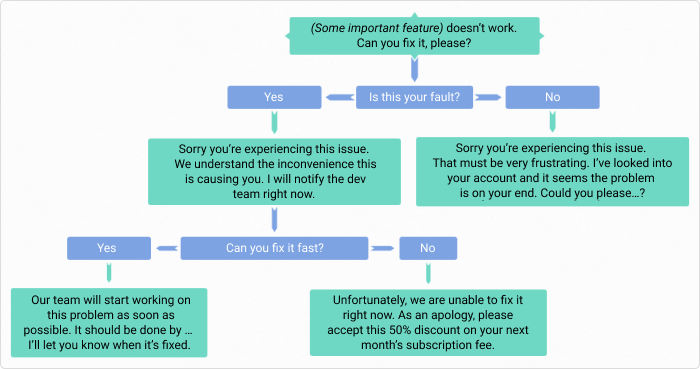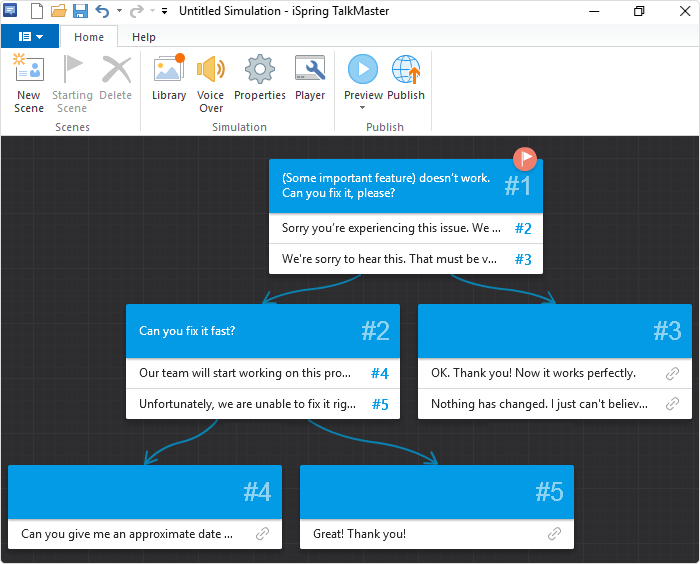13 Customer Service Role-Play Scenarios: (+Scripts to Master)

Customer service mistakes are dangerous. They can cost your company a great deal of money.
Businesses lose $75 billion in revenue from customers who choose another brand to work with because of poor customer care, according to the Gladly Customer Expectations Report.
With great support comes a strong customer relationship. And a guaranteed way to make it great is by teaching your team about possible customer service scenarios and how to handle them.
In difficult customer service scenarios, it’s hard to come up with an immediate answer or solution. But the good news is that most of them are repetitive and fall into a finite number of categories. No matter what customer service situation you’re dealing with, role-playing is the best way to train new employees and provide continuous professional development.
In this article, we provide you with some of the most popular role-play scenarios and share our insights on how to move customer service training online with iSpring Suite.
What Are Role-Play Scenarios?
Role-play scenarios are those in which two or more people act out specific roles.
Usually, a senior member of your company (e.g., manager, supervisor) or learning and development representative will play the role of an angry or disgruntled customer, and your employees will come up with a solution on the spot. Based on their responses, the trainer will be able to bridge knowledge gaps and/or point them in the right direction.
As a company owner or hiring manager, you can also use role-play scenarios during the onboarding process to assess how a newcomer would approach typical situations in your company.
Simply stage a scene and give them time to think about how they would react. Their response will determine whether they would be a good fit, whether they’re knowledgeable and experienced, or whether you should pass on them.
Customer service role-play scenarios can help you train employees and, therefore, improve customer service in your organization.
Benefits of Role-Plays
Many businesses use role-plays as part of their training programs. Why? Check out some of the benefits of role-plays:
- Building confidence for actual situations
- Finding the best approaches
- Fewer mistakes in real life
- Better communication skills
- Solution of customer problems
How to Use Role-Play Scenarios in Customer Service
If you’re thinking about adding role-play activities to your customer service training sessions but aren’t sure how to do this,
here are 5 steps you can follow:
Step 1: Introduce the issue
Before starting your role-play, gather participants in a classroom or your usual training space and introduce the topic. Your role-play can be about everyday situations or unusual cases, depending on the goals you set.
Provide the participants with instructions on the training process. You can also explain why you decided to address the issue, the purpose of the role-play, the desired outcome, and then let trainees discuss the issue.
Step 2: Provide details
Once you introduce the session, share the background information, more details about the issue, the scenario, and the ways to act during the role-play. Make sure to give enough details about the imaginary situation to make it feel as realistic as possible.
Step 3: Assign roles
Introduce the characters involved in the scenario and assign roles to trainees. For example, if you act out the impatient customer scenario, you will have two roles on different sides of an argument: a customer and a representative.
Ensure that the trainees understand their roles and tasks as outlined in the assignment.
Step 4: Act out a scenario
Now, have the trainees perform their roles while their peers watch. You might advise your trainees to intensify the situation gradually. For example, an impatient customer might start out calm and then get irritated and angry.
Step 5: Discuss the experience
Regardless of the role-play’s outcome, it’s crucial to discuss it with all participants. If a person fails to find the correct approach, invite trainees to analyze the reasons why, such as a lack of persuasion or communication that was too aggressive, and suggest different strategies. And if someone finds the appropriate solution for the issue, discuss what made it effective and if there could be alternative solutions.
Different perspectives can lead to truly great approaches in different customer service scenarios. Make sure to listen to all the participants in the training session. This type of training is all about collaboration and teamwork.
The 13 Most Popular Role-Play Scenarios
Here are 13 examples of role-play scenarios with typical sample responses in customer service:
- The impatient customer
- A product fails to meet expectations
- The angry customer
- The frugal customer
- Onboarding training request
- When you don’t know the answer
- The defective-product customer
- The feature-request customer
- When a customer violates your terms of service
- Addressing a billing discrepancy
- Unclear support documents
- Excessive customer service automation
- Handling a product recall
Let’s take a closer look at each of them.
Role-Play Scenario #1: The Impatient Customer
A customer ordered a product online, and they still haven’t received it after the scheduled delivery date has passed. They are irritated and demand a refund. While the late delivery might not be your fault, and the customer’s attitude might trigger defensiveness, it’s important to apologize and let them know you’re fixing the issue. One of the potential ways to resolve the situation is to offer a discount or free shipping on their next order.
Script sample
Customer: I ordered a product 2 weeks ago, and it was supposed to arrive 3 days ago. What’s going on?
Representative: My sincerest apologies. Late deliveries can be a real pain. I assure you that we’re doing everything possible to resolve this issue for you. And as a gesture of appreciation for your understanding, we would be happy to give you a 10% discount on your next purchase.
Role-Play Scenario #2: A Product Fails to Meet Expectations
A customer bought a new gaming computer and claims that it doesn’t meet the characteristics specified by the manufacturer. Keep in mind that not everything is lost in this situation. Instead of simply issuing a refund, try to find out the nature of the dissatisfaction and recommend an alternative solution.
Script sample
Customer: Hi there, I bought this computer 3 days ago, but it doesn’t perform as well as described on the website. I chose my platform and the games I would be playing, but the computer doesn’t come anywhere close to hitting the frame rate that the manufacturer said it would, even at the lowest graphic settings. I’d like to return it.
Representative: Hey there! No problem. You can return it or exchange it for a different computer. Many of our customers are serious gamers, and they speak highly of this (other) model. Why don’t you demo it and let us know what you think?
Customer: Wow! This computer’s great! I hope I won’t regret it if I decide to exchange the one I purchased.
Role-Play Scenario #3: The Angry Customer
An angry customer is yelling over the phone about a software malfunction that is jeopardizing an important project. The customer’s emotions have gotten the best of them. Using positive language, try calming them down by apologizing and showing empathy for their situation – regardless of whether the company or customer is at fault. Then, attempt to resolve the issue.
Script sample
Customer: This isn’t the first time your software has glitched out on me! I pay a lot of money to use this presentation tool, and if I don’t complete the project by tomorrow, I risk losing a major client!
Scenario 1: The issue is on the client’s side
Representative: I’m very sorry you’re experiencing this issue. That must be very frustrating. I’ve looked into your account, and the problem seems to be that you’re using a previous version of the software. I’ve sent you a link to the latest version. Please download it, try again, and let us know if you still run into any issues. We’re always here to help.
Scenario 2: The company’s at fault
Representative: I’m very sorry you’re experiencing this issue. There is a system-wide server error, but we can assure you that the issue will be fixed very soon. Regardless, we recognize the inconvenience this is causing you. As a gesture of our appreciation for your understanding, please accept this 50% discount on your next month’s subscription fee.
Role-Play Scenario #4: The Frugal Customer
A customer is keen to purchase your product but has expressed dismay at the price. While prices are normally fixed, rather than simply dismissing the customer’s request with a “too bad, so sad” attitude, calmly justify the price by describing the product’s unique features. And if possible, find another way to ease the financial load, such as a free add-on or financing.
Script sample
Customer: Hi there. I’d love to purchase this vehicle, but its price is way beyond my budget, so I’ll have to pass.
Representative: I understand that the price is steep for you, but this car is durable and fuel-efficient – it achieves up to 48 MPG on the highway. So, the price is actually reasonable. Over time, if you take into account the money you save on gas and car repairs, you’ll see that the vehicle practically pays for itself! However, what we can offer you is 0% financing over the next 5 years. Would that work for you?
Role-Play Scenario #5: Onboarding Training Request
In this scenario, a customer seeking help with onboarding and training to make sure his team can effectively use the learning management system. They don’t know where to start and are looking for guidance. The customer service representative should provide accurate and helpful information to guide the customer toward a successful implementation of the LMS.
Script sample
Customer: We recently purchased the new LMS and need assistance with onboarding and training for the team. Can you provide us with detailed information about the implementation process and training resources?
Representative: Absolutely. We understand the importance of effective onboarding and training for your team. Before we proceed, I would like to know what degree of experience your team has with eLearning platforms.
Are there specific features or functionalities you would like to prioritize in the onboarding process? Using this information, I’ll arrange training and prepare follow-up materials tailored to your needs.
Role-Play Scenario #6: When You Don’t Know the Answer
A customer is keen on one of your top-selling products and wants to know when it will be back in stock. If you simply say “I don’t know” or “Check back later,” they might dismiss the purchase altogether. The best thing to do here is to assure them that you’ll get back to them with an answer. And before they potentially decide to go elsewhere, recommend alternative products that are in stock.
Script sample
Customer: Hello! I’m very interested in buying one of your down-feather jackets. The price is right, and it’s exactly what I’m looking for. But unfortunately, it’s out of stock. Do you know when you’ll be getting more?
Representative: Hi there. We recently ran out, and unfortunately, we’re not sure when our new shipment will come in as it depends on our supplier. However, in the meantime, here is a link to our similar brands. Please feel free to check them out. We’ll contact our supplier and let you know as soon as we get a reply. What is the best way to contact you?.
Role-Play Scenario #7: The Defective-Product Customer
A customer comes into your store complaining about a defective item that they purchased. Instead of hastily blaming the customer, empathize with them since they’re probably upset about a well-thought-out purchase that turned out to be of inferior quality. The good news is that, in these situations, they’re usually looking for an exchange rather than a refund. To seal the deal, apologize to the customer and provide them with an answer on the spot.
Script sample
Customer: Good afternoon! I recently purchased a swivel chair from your store, but every time I pivot, it makes a loud, irritating squeak.
Representative: Wow. We’re very sorry to hear that. That must feel very uncomfortable. We don’t hear of this issue too often, so it might be due to a manufacturing defect. We’d be more than happy to send you a new one right away.
Role-Play Scenario #8: The Feature-Request Customer
A customer contacts your technical support team with ideas on how you can improve your product. Customers often provide invaluable insights that can help your company thrive and grow. Whether or not you can fulfill the request, it’s important to first thank the customer for the time they’ve taken to share it with you and explain how and when you plan to implement it, or why you won’t be able to.
Script sample
Customer: Hi! I’ve been using your product for a few months now, and so far, everything is great! However, I feel that it’s lacking in branding customization options. Will you be able to add more functionality to the next update?
Scenario 1: Your company can add more functionality
Representative: Hello there! Thanks for your feature request. We welcome our customers’ suggestions on how to enhance our product. To help us prioritize our resources, please let us know what specific branding flexibilities you’re looking for. Then, I’ll share this information with our development team.
Scenario 2: Your company can’t add more functionality
Representative: Hello there! Thanks for your feature request, but due to limited resources, we are unable to implement this functionality in the near future. That being said, many customers have made similar requests, so we’re taking it very seriously. For the moment, we’ll add it to our backlog, and you will definitely be notified when we’re ready to implement more branding options.
For the time being, our platform integrates many WordPress plug-ins that allow for more flexibility. Here’s a link to some of the most commonly used plug-ins. Please feel free to contact us if you need any help.
Role-Play Scenario #9: When a Customer Violates Your Terms of Service
A customer purchased a VPN service and has violated the terms of service by installing it on multiple devices. While it can be awkward to tell a paying customer that they’re in breach of your terms of service, there’s a way to go about it that both gets your point across and preserves their dignity. The key here involves refraining from dubious assumptions. You need to determine their needs and attempt to fulfill them.
Script sample
An email from a representative: Dear [customer’s name],
We’re reaching out to you because we’ve noticed that you’ve installed our VPN software on multiple devices while registered with our single-device package. Were you planning on upgrading to one of our multi-device packages instead? Please let us know, and we’ll set you up with the right package for your needs.
Since these scenarios are typical for all customer service managers, it makes sense to automate staff training and deliver it online.
Role-Play Scenario #10: Addressing a Billing Discrepancy
After receiving the invoice for recent services, the customer notices that the total amount is higher than the initial quote provided. They are concerned about the unexpected increase in charges and call customer service seeking an immediate resolution.
Script sample
Customer: I just received my bill for the car detailing services, and it seems to be higher than what I was quoted. I need this issue resolved immediately.
Representative: I apologize for the inconvenience. Accurate billing is important to us, and we always try to provide excellent customer service. Let’s review your billing statement together to identify the specific services and costs. We’ll find a prompt solution to address any discrepancies.
Role-Play Scenario #11: Unclear Support Docs
In this scenario, a CRM administrator is experiencing issues with an email campaign targeted at retaining customers. They call customer support for help, feeling frustrated with the steps provided in the technical manuals. This scenario highlights the importance of clear instructions, effective communication, and problem-solving in technical situations.
Script sample
Customer: I’m having trouble setting up the retention email campaign. I followed the instructions from the manual, but nothing works as described. Could you help me get it to work?
Representative: We understand that this can be challenging because every step matters, no matter how small. I suggest we try it together so I can understand specifically what doesn’t work. Please share your screen, and we’ll go through it step by step. Then, we’ll investigate further and get back to you with a detailed response.
Role-Play Scenario #12: Excessive Customer Service Automation
The customer is irritated by excessive customer service automation. They finally get a customer care representative on the line and want to know which options to choose in order to avoid these unnecessary automated responses next time. The role-plays will focus on effectively communicating with the customer, addressing their concerns, and providing guidance on alternative support options.
Script sample
Customer: Finally! A human on the line! I’m tired of dealing with automated responses every time I need help, and I didn’t expect such a poor experience with your company. Can you provide me with alternative support options? I need to speak to a real person and get my issues sorted out quickly.
Representative: I understand your frustration. We usually receive common questions from customers, which our automated responses can easily answer. However, if you’re sure your question is atypical and requires immediate human contact, please press “9” after the first automated question. This will transfer your call directly to a customer care representative.
Role-Play Scenario #13: Handling a Product Recall
The situation isn’t something to be dealt with on a daily basis, but when it happens, your team should be prepared to offer excellent service.
The customer asks about a product recall for a smartphone they purchased six months ago. They received an email about the recall and are concerned about product safety. This role-play focuses on addressing customer concerns and providing guidance on the recall process.
Script sample
Customer: I purchased a smartphone six months ago and just received an email about a product recall. Can you provide me with more information and guidance on what to do?
Representative: Sure, I can help you with that. Our top priority is your safety. That’s why we have to discontinue and recall this model, as we’ve received reports of overheating batteries and fires.
Let’s start by reviewing the specific details of the recall, and then I’ll guide you through the steps to return the product and address any concerns you may have
How to Move Customer Service Training Online
You can convert customer service scenarios into dialogue simulations by using a course authoring tool such as iSpring Suite. Dialogue simulations are exercises that imitate real customer interactions with a person and help people master communication skills with no risk of damaging the relationship with a client.
The first step in building role-play scenarios is visualizing them as a flowchart. For example, you can create a mind map online by using coggle.

As illustrated in the mind map above, each type of scenario branches into multiple options. For example, if a customer is having an issue with a product, the first step toward resolving it is determining who is responsible.
As shown above, if the issue originates from the company’s side, it requires different responses compared to when it stems from the client’s end.
However, how do you express all these different options in a way that allows your employees to navigate this naturally in a virtual environment?
Well, with iSpring Suite, you can build a dialog tree, a well-organized structure that you can manipulate with a single mouse click.

To make the conversation even more complex and realistic, you can add locations and characters. You can upload your own images or use the built-in collection. Content Library, which comes with an iSpring Suite Max subscription, offers a wide range of characters from various ages, ethnicities, and professions, along with an extensive selection of backgrounds appropriate for business, manufacturing, education, medical, and travel settings.
Check out this iSpring demo to get a better idea of what these powerful scenarios look like.
While these dialogue simulations might look technologically sophisticated, they are quite easy to navigate with the right software and guidance.
Read our article on how to improve your employees’ communication and negotiation skills using dialogue simulations.
The best part of online customer service scenarios is that your employees can dive deep into a simulation while selecting responses that naturally align with how they would act in real life. Based on their responses and your predesigned branched scenarios, they’ll be able to experience the productive and counterproductive consequences of actions and responses chosen in a risk-free environment and receive positive feedback on their progress.
To Sum Up
Customer service is core to the success of any thriving business. You should never underestimate the power of a happy customer, negative press, or word of mouth.
The way your employees interact with customers can make or break your business reputation. That’s why you should never take employee training for customer service lightly.
As people learn best through experience, creating a virtual environment that’s immersive, engaging, and risk-free is the best approach.
If you’d like to create customer service scenarios, interview questions and answers, or simulate situations surrounding software troubleshooting, sales techniques, and more, then you can get started today by downloading a free trial of iSpring Suite!





